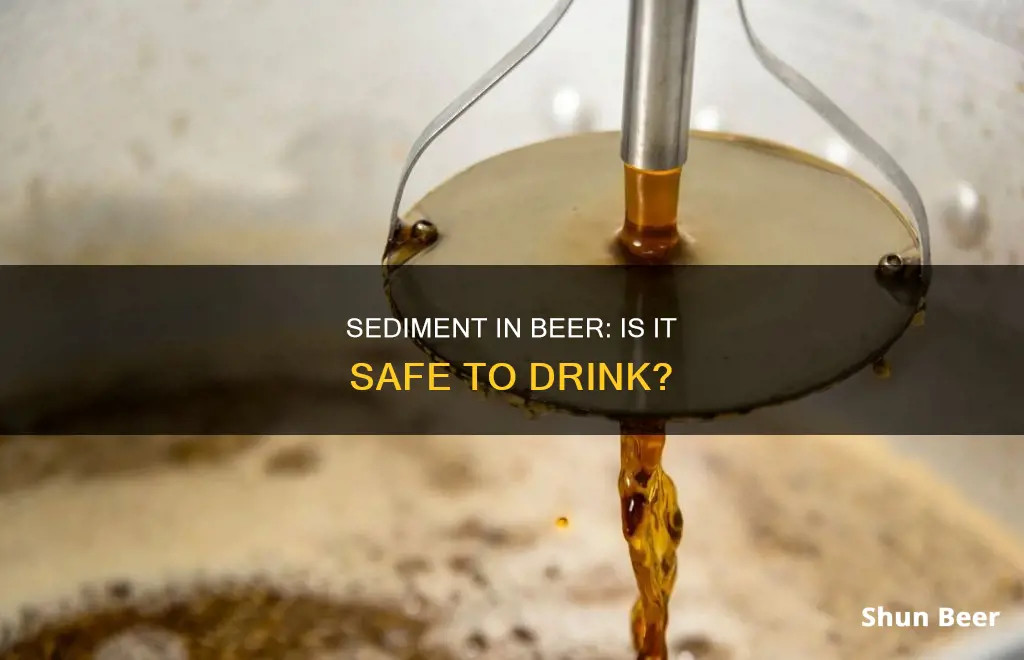
Sediment in beer is a common occurrence, often seen in cloudy beers like New England-style IPAs and unfiltered ales. These sediments are composed of yeast and protein particles resulting from the brewing process. While some people choose to avoid drinking the sediments, it is entirely safe to consume them. Bottle-conditioned beers, for example, are living products with active yeast that enhances the flavour and keeps the beer fresh for longer. However, personal preferences vary, and some people choose to decant or store the beer upright to let the sediments settle at the bottom. Ultimately, it is up to the drinker whether they want to include the sediments or not, as it will not cause any harm either way.
| Characteristics | Values |
|---|---|
| Is it safe to consume sediments in beer? | Yes, it is safe to consume sediments in beer. |
| What are sediments in beer? | Sediments in beer are primarily yeast and protein particles from the brewing process. |
| Why does it occur? | It occurs due to the brewery choosing not to filter or pasteurize its beer before bottling or kegging, or due to bottle conditioning. |
| Is it acceptable? | Sediments are acceptable in many beer styles and are a natural cause. |
| How to avoid sediment in fresh beer? | Store the beer upright and let the sediment sink to the bottom. |
| How to serve beer without sediment? | Pour around two-thirds of the beer into a glass, then carefully tilt the bottle and pour the rest until you see the sediment near the lip of the bottle. |
What You'll Learn

Sediment is a natural part of the brewing process
Hazy beers, such as New England-style IPAs and unfiltered ales, often have a solid layer at the bottom of the beer that makes the beer cloudy when poured into a glass. This haze is created by the interaction of proteins with yeast and polyphenols. By bypassing the filtration step, brewers keep these compounds in solution, adding to the pillowy-soft mouthfeel of the beer and providing the desired haze.
Bottle conditioning is another process that can lead to sediment in beer. This involves adding a small amount of active yeast and simple sugars to the bottle before sealing it off. The yeast continues to ferment the beer, creating carbonation and increasing the alcohol content. After fermentation is complete, yeast cells clump together and form a thin cake at the bottom of the bottle. When the bottle is agitated, these particles are suspended in the beer, creating the sediment you see.
While sediment may not be aesthetically pleasing, it is perfectly safe and edible. It is a beneficial signature of an authentic hazy beer. Some people even believe that drinking the sediment gives them an appreciation for the beer as the brewery intended. However, if you prefer your beer without sediment, you can store the beer upright to let the sediment settle at the bottom, and then carefully pour it into a glass, being careful to stop pouring when you see the sediment near the lip of the bottle.
Beer and Amoxicillin: Is It Safe to Drink?
You may want to see also

Sediment is safe to consume
Sediment in beer is perfectly safe to consume. In fact, it is a natural part of the brewing process and is even encouraged by some brewers. Sediment is primarily composed of yeast and protein particles, which can come from two sources. Firstly, some breweries choose not to filter or pasteurise their beer before bottling or kegging, leaving sediment in the final product. Secondly, it can be a result of bottle conditioning, where sugar or wort (unfermented beer) is added to beer with live yeast. This process allows the beer to naturally carbonate and increase its alcohol content.
While some people may find the idea of drinking sediment unappealing, it is not harmful and can even be beneficial. Yeast is a good source of vitamin D, and some people enjoy the enhanced flavour it can bring. In fact, drinking the sediment can give you an appreciation for the beer as the brewery intended.
However, it is important to note that the presence of sediment can sometimes indicate that a beer is too old. Old beer sediment tends to look like dandruff, and it is recommended to avoid drinking it. To avoid this, simply store your beer upright to let the sediment settle at the bottom.
Ultimately, whether or not to drink the sediment in your beer is a matter of personal preference. Some people choose to pour carefully and leave the sediment behind, while others embrace the floaties and yeasties. So, the next time you see those cloudy particles in your beer, rest assured that they are safe to consume and may even enhance your drinking experience!
Beer Drinking in Oklahoma: Sunday's Special Rule
You may want to see also

Sediment can enhance the flavour of beer
Sediment in beer is an entirely natural, safe, and edible byproduct of the brewing process. It is composed of yeast and protein particles, which can come from two things: a brewery choosing not to filter or pasteurize its beer before bottling, or bottle conditioning.
Bottle conditioning is when sugar or wort (unfermented beer) is added to beer with live yeast. The yeast eats the sugar, continuing to ferment the beer and creating CO2, keeping the beer fresh for longer. This process can also increase the ABV (Alcohol By Volume). As a result, bottle-conditioned beers are living products and are safe for consumption.
Some people choose to avoid sediment in their beer, and this can be achieved by storing the beer upright so that the sediment settles at the bottom of the bottle. However, drinking the beer with the sediment can enhance the flavour and provide a more authentic experience.
For example, hazy beers are unfiltered and have a higher protein content, which contributes to their characteristic haze and pillowy-soft mouthfeel. By bypassing the filtration step, brewers keep the yeast, proteins, and polyphenols in the beer, adding to its complexity. Drinking the beer with the sediment can provide a more authentic hazy beer experience, as intended by the brewer.
Additionally, some people believe that drinking the sediment allows them to appreciate the beer as the brewery would have wanted. While some breweries recommend leaving the sediment undisturbed, others suggest the swirl-and-pour method, indicating that drinking the sediment may be encouraged in certain styles.
In conclusion, while personal preferences vary, drinking the sediment in beer can enhance the flavour and provide a more authentic, complex, and flavourful experience, particularly for hazy and unfiltered beers.
Beer and Amoxicillin: Is It Safe to Drink?
You may want to see also

Sediment can be avoided by storing the beer upright
Sediment in beer is usually composed of yeast and protein particles that result from the brewing process. It is safe to consume and is even encouraged by some breweries, especially for wheat beers and most Belgian styles. However, if you want to avoid sediment in your beer, it is important to store the bottles upright. This allows the sediments to settle at the bottom of the bottle, creating a clear beer that can be carefully poured without disturbing the sediment.
Storing beer upright is a simple and effective way to avoid sediment in your drink. When the bottle is upright, gravity naturally pulls the sediment to the bottom, creating a distinct layer. This process ensures that the beer above remains clear and free of any floating particles. By storing the beer this way, you can be confident that each pour will be sediment-free, without having to worry about the swirling or decanting techniques that some drinkers use.
Additionally, storing beer upright helps to preserve the intended flavour profile of the brew. Sediment can affect the taste of the beer, and some drinkers may prefer to avoid this. By keeping the beer upright, you ensure that the yeast and protein particles remain separated from the liquid, resulting in a purer flavour that more closely aligns with the brewer's original vision. This is especially important for beers that are not meant to be drunk with the sediment, as some breweries will specify.
For those who prefer their beer sediment-free, storing the bottles upright is a convenient and reliable solution. It requires no additional equipment or complex techniques, just a simple adjustment to how you store your beer. By letting gravity do its work, you can ensure that each pour is clear and free of any unwanted particles, creating a more aesthetically pleasing and consistent drinking experience.
While some beer enthusiasts embrace the presence of sediment, others may prefer their beer clear and undisturbed. By storing the beer upright, you gain the flexibility to choose. When it's time to serve, simply open the bottle and carefully pour, leaving the sediment at the bottom. This way, you have the option to include or exclude the sediment, depending on your preference or the style of beer you're enjoying.
Beer and Clarithromycin: Is It Safe to Drink?
You may want to see also

Sediment is a signature of an authentic hazy beer
Sediment in beer is comprised of yeast and protein particles that clump together and fall out of the liquid, either settling at the bottom of the container or floating in suspension. Sediment is a natural part of the brewing process and is safe to consume. In fact, yeast can even enhance the flavour of some beer styles, such as Hefeweizens, which are meant to have a nice dose of yeast mixed into the beer to complete the flavour profile.
Sediment is formed in a few different ways. Bottle conditioning is a process where a small amount of active yeast and simple sugars are added to the bottle before sealing it off. In some cases, bottles are packaged while they are actively fermenting. This allows the beer to naturally carbonate and increase the ABV (Alcohol By Volume). After fermentation is complete, yeast cells clump together and drop to the bottom, forming a thin cake. When the bottle is agitated, these particles are thrown back into suspension, creating the sediment.
Aged beers are also bottle conditioned and have yeast in suspension to ferment out any complex sugars present in the bottle. High-gravity beer styles such as barley wines, imperial stouts, and barrel-aged beers are suitable for cellaring and are dosed with yeast at the time of packaging. While strong ales improve with age, this is not the case for many other beers. In styles where ageing is not appropriate, the liquid breaks down, proteins clump together, and hop character diminishes over time. The beer becomes oxidised and tastes stale or musty. In this case, the sediment tends to look like snowflakes, but it is still safe to consume.
Another cause of sediment is dry hopping, which creates haze and releases tiny hop particles into the beer over time. This is common in aggressively hopped beers like IPAs, New England IPAs, or Double IPAs. While some breweries filter out these hop particles, they are safe for consumption and hazy New England-style IPAs traditionally remain unfiltered.
Some beers, such as German Hefeweizen, Belgian Witbier, American Wheat, and hazy New England IPA, are naturally cloudy post-fermentation and are traditionally served unfiltered. Unfiltered IPAs, when dry-hopped, have a lot of polyphenols from hops that bond with proteins, creating a "chill haze".
In summary, sediment is a natural part of the brewing process and is safe to consume. In fact, for hazy beers, it is a signature of authenticity, as these beers are meant to be unfiltered and will therefore always have some amount of sediment. So, the next time you see those "floaties" in your beer, don't be alarmed – they're all part of the unique character of a hazy brew!
Beer Blues: Bad Brews Make You Sick?
You may want to see also
Frequently asked questions
Yes, it is safe to drink the sediment in beer. Sediment is usually made up of yeast and protein particles that are byproducts of the brewing process.
Sediment can be the result of a brewery choosing not to filter or pasteurise its beer before bottling or kegging. It can also be the result of bottle conditioning, where sugar or wort is added to beer with live yeast.
To avoid sediment, store your beer upright so that the sediment settles at the bottom of the bottle or keg. When serving, pour two-thirds of the beer into a glass, then carefully tilt and pour the rest until you see the sediment near the lip of the bottle.
This is a matter of personal preference. Some people believe that drinking the beer with the sediment gives them an appreciation for the beer as the brewery would have wanted. However, some breweries recommend leaving the sediment behind, so it is best to check with the specific brewery.







